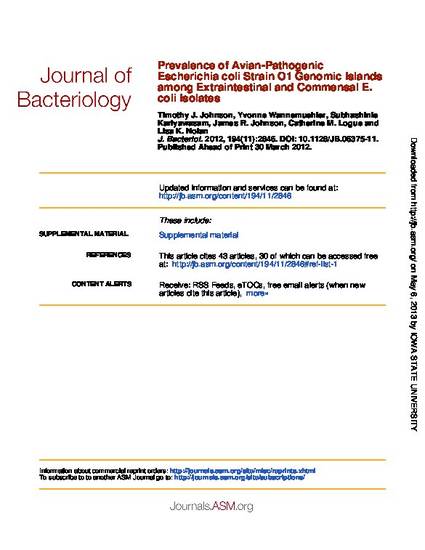
Article
Prevalence of Avian-Pathogenic Escherichia coli Strain O1 Genomic Islands among Extraintestinal and Commensal E. coli Isolates
Journal of Bacteriology
Document Type
Article
Disciplines
Publication Date
6-1-2012
DOI
10.1128/JB.06375-11
Abstract
Escherichia coli strains that cause disease outside the intestine are known as extraintestinal pathogenic E. coli (ExPEC) and include pathogens of humans and animals. Previously, the genome of avian-pathogenic E. coli (APEC) O1:K1:H7 strain O1, from ST95, was sequenced and compared to those of several other E. coli strains, identifying 43 genomic islands. Here, the genomic islands of APEC O1 were compared to those of other sequenced E. coli strains, and the distribution of 81 genes belonging to 12 APEC O1 genomic islands among 828 human and avian ExPEC and commensal E. coli isolates was determined. Multiple islands were highly prevalent among isolates belonging to the O1 and O18 serogroups within phylogenetic group B2, which are implicated in human neonatal meningitis. Because of the extensive genomic similarities between APEC O1 and other human ExPEC strains belonging to the ST95 phylogenetic lineage, its ability to cause disease in a rat model of sepsis and meningitis was assessed. Unlike other ST95 lineage strains, APEC O1 was unable to cause bacteremia or meningitis in the neonatal rat model and was significantly less virulent than uropathogenic E. coli (UPEC) CFT073 in a mouse sepsis model, despite carrying multiple neonatal meningitis E. coli (NMEC) virulence factors and belonging to the ST95 phylogenetic lineage. These results suggest that host adaptation or genome modifications have occurred either in APEC O1 or in highly virulent ExPEC isolates, resulting in differences in pathogenicity. Overall, the genomic islands examined provide targets for further discrimination of the different ExPEC subpathotypes, serogroups, phylogenetic types, and sequence types.
Copyright Owner
American Society for Microbiology
Copyright Date
2012
Language
en
File Format
application/pdf
Citation Information
Timothy J. Johnson, Yvonne Wannemuehler, Subhashinie Kariyawasam, James R. Johnson, et al.. "Prevalence of Avian-Pathogenic Escherichia coli Strain O1 Genomic Islands among Extraintestinal and Commensal E. coli Isolates" Journal of Bacteriology Vol. 194 Iss. 11 (2012) p. 2846 - 2853 Available at: http://works.bepress.com/lisa_nolan/27/

This article is from Journal of Bacteriology 194, no. 11 (June 2012): 2846–2853, doi:10.1128/JB.06375-11.